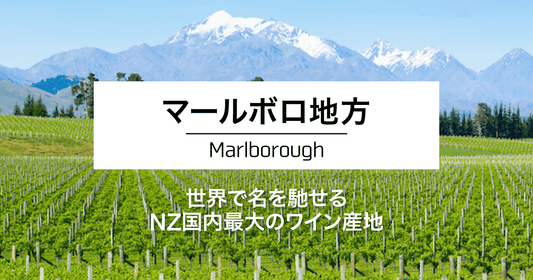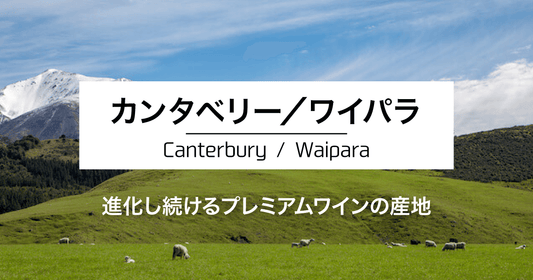
The Hawke's Bay region , which stretches along the large, arching bay, is located on the eastern side of New Zealand's North Island.

It is a very attractive region with a variety of faces, from the fertile land of spreading plains to the beautiful bay scenery, and the lively towns of Napier and Hastings .

It is also one of New Zealand's leading wine producing regions. Its total cultivated area is the second largest after Marlborough, the largest wine producing region in the country. There are also many wineries, making it a major wine producing region in the country.
The main grape varieties represented are:
- Cabernet Sauvignon
- Merlot
- Syrah
These three types of red wine grapes have the largest cultivation area and production volume in New Zealand, and their quality is highly regarded internationally.
Among them, the variety that has seen the greatest increase in cultivation area is Syrah . It now accounts for about 70% of the cultivation area in Japan and is a variety that has been attracting a lot of attention in recent years.
And here in Hawke's Bay, there's an important sub-region you should know about.
The area is called "Gimlet Gravels."
This is a grape-growing region that was created as a result of the Hawke's Bay earthquake, which occurred in 1931 and is said to be the worst natural disaster in New Zealand's history.
How on earth are earthquakes and grape-producing regions connected?
There's a very interesting fact behind this, which could even be called miraculous...! I'll explain it in more detail later.
Another notable city is Napier , which has been beautifully rebuilt following the earthquake disaster, with many of its stunning Art Deco buildings being rebuilt.
Napier Airport is about an hour's flight from Auckland, the country's largest city. It is also the gateway to the Hawke's Bay region, and many of the wineries are easily accessible from Napier Airport, making it a very convenient region for tourists.
Although it is still a relatively unknown region in Japan, there is much more to see than wine, making it a region that everyone should get to know.
Here we take a closer look at the Hawke's Bay region, which has plenty to offer.
New Zealand's oldest wine region
The history of grape cultivation in the Hawke's Bay region dates back to the 1850s, when wine was made for use in Catholic masses . New Zealand is said to be a wine-emerging country, but the region has a particularly long history and has a long tradition of producing high-quality wines.
In Christianity, wine is an essential part of the mass.
The first commercial wine was produced in 1905.
"Vidal Estate" is established. Over 100 years later, Vidal Estate is still the leading winery in Hawke's Bay.
Although there are large commercial wineries like this, there are also many small wineries, each of which puts their effort and passion into winemaking.
Little rain and plenty of sunshine
Hawke's Bay is a region with relatively little rain throughout the year, thanks to the mountains to the west. The average annual rainfall in Tokyo is about 800mm, which is about half the average annual rainfall in Tokyo, which is about 1,500mm.
Another notable feature is that the amount of sunlight is about 2,200 hours, which is longer than other regions in the country (the average in New Zealand is about 2,000 hours per year). The high amount of sunlight provides an ideal environment for growing fruit.
The temperature during the summer (January) when grapes grow is
- The maximum temperature is 25℃
- The lowest temperature is 14℃
A minimum temperature of 14°C in summer feels quite cool for us in Japan.
After the long summer comes the dry autumn.
Another feature of Hawke's Bay is that it is a very large area, so the weather in each sub-region is very diverse, which can mean that harvest times can differ by more than a month.
In this way, even though they are from the same region, there are differences between each subregion, and it is interesting to be able to enjoy the complexity and individuality of each wine.
The varieties cultivated
In the Hawke's Bay region,
-
White Wine Grape Varieties
- Sauvignon Blanc
- Chardonnay
-
Red wine grape varieties
- Merlot
- Syrah
- Cabernet Sauvignon
- Sangiovese
These varieties are cultivated in the area, and the region has established an important position in New Zealand, mainly as a producer of Bordeaux varieties (Merlot, Cabernet Sauvignon) and Syrah.
In recent years, Syrah has been attracting a lot of attention, with the area of cultivation increasing rapidly.
Hawke's Bay Syrah is aromatic and spicy
Syrah is a grape variety that originates from the Rhone region of France.
It was introduced from France to Australia, where it evolved into "Shiraz" and spread to countries around the world. It is a disease-resistant and easy-to-grow variety, and in recent years, the area of cultivation around the world has been increasing. It is a popular variety, with the amount of cultivation increasing five-fold in the 20 years from 1990 to 2010.

Generally speaking, grapes are best grown in cool climates, but Syrah is a variety that prefers a warm, dry climate, so the Hawke's Bay region, which has one of the warmest climates in New Zealand, is well suited to growing it.
The Hawke's Bay Syrah is characterised by its aromatic and spicy flavour, which is combined with elegance to produce wines with excellent overall balance.
Production areas concentrated along rivers

The Hawke's Bay region is bordered by the
- River Esk
- Nagarul-ro River
- Tukituki River
There are three rivers running through it.
The area around the river mouth is an alluvial fan formed by the accumulation of sediment, and vineyards are concentrated on this alluvial fan.
The soil, which is formed by the accumulation of soil and sand carried by the rivers, varies slightly from river to river, resulting in a wide variety of wines.
Here we will introduce some representative subregions.
Esk River Valley
The Esk River Valley is the northernmost sub-region of the Hawke's Bay region and is classified as a coastal area.
This place is especially warm thanks to the sea breeze. There is no frost in the winter. This is a perfect environment for grape cultivation, as frost is the enemy.
The winery here, Esk Valley Estate, is highly regarded.
Esk Valley Estate
Esk Valley Estate , part of New Zealand's leading winery, VILLA MARIA, is one of the region's leading wineries.
Located just a 10-minute drive from Napier Airport, this winery is extremely accessible and popular with tourists.
The winery has a small cellar door.
Esk Valley Estate's Merlot-dominant blended wine is a symbol of New Zealand red wine, full-bodied and rich in flavour.
In addition, the winery has received various awards and is highly regarded.
Gimlet Gravels
Gimblett Gravels is not a well-known wine-producing region in Japan, but the wines produced here have been highly acclaimed internationally in recent years.
The area known as Gimlet Gravels is a gravelly area covering approximately 800 hectares around the lower reaches of the Ngarulolo River.
The average summer temperature is 2-3 degrees higher than in other subregions, and it is also characterized by being drier, which results in more concentrated grapes producing more powerful wines.
90% of the grapes grown are for red wine.
- Merlot
- Syrah
- Cabernet Sauvignon
- Malbec
- Cabernet Franc
Many different varieties are cultivated.
They specialize in Bordeaux Blend and Syrah red wines, both of which are characterized by their spicy and rich tannins.
Bordeaux Blend is a traditional method used in the Bordeaux region of France to blend multiple varieties, including Cabernet Sauvignon and Merlot.
By blending, the characteristics of the multiple varieties, such as acidity, astringency, and sweetness, create complexity, resulting in a wine with a deep flavor.
So how did the Gimlet Gravels region come about? As mentioned at the beginning, the 1931 Hawke's Bay earthquake played a major role in its creation.
The Hawke's Bay earthquake was said to be the worst natural disaster in New Zealand's history, and it significantly altered the region's topography.
A sacred place born from an earthquake
The magnitude 7.8 earthquake that struck the Hawke's Bay region on February 3, 1931 killed a combined 258 people in the nearby cities of Napier and Hastings, causing devastating damage to the city.
The ground rose by up to four metres, and even uprooted the flowing Ngagarulolo River, changing its course and revealing a gravelly riverbed in its place.
However, it was discovered that the riverbed could be used for farming and housing, and it also attracted a lot of attention as a suitable soil for growing grapes.
The soil that was once the riverbed is now sand, gravel and stones.
This means that the soil is low in nutrients, allowing the roots to grow well, and the soil has good drainage so the soil does not rot. This is the best soil for grapes.
The gravelly soil also retains plenty of solar heat during the day and keeps the temperature low at night, creating an ideal environment for growing grapes.
The "GRAVELS" in Gimlet Gravels means gravel.
As the name suggests, the soil is mostly gravel and was once considered "the poorest and least productive in Hawke's Bay" .
However, thanks to the efforts of the pioneers, the area became highly coveted by producers, and eventually land prices began to skyrocket!
In 2001, the Gimblett Gravels Winegrowers Association was established, an organization of producers who own land. The area is now a registered trademark for growing wine grapes.
Members of this group can label their wines as "Gimblett Gravels" or "Gimblett Gravels Winegrowing District."
This is the official website of the Gimblett Gravels Winegrowers Association.
It's clear that all of these producers are very proud to be making wine at Gimlet Gravels.
What you can buy in Japan:
- Trinity Hill
- CRAGGY RANGE
There are items like these, but they may be hard to find.
If you can find a wine in Japan with "Gimblett Gravels" on the label, please give it a try! It's a very rare treat.
Is it really that hard to find?
Yes, I think you would be very lucky if you could find one!
Gimlet Gravels was once a riverbed.
The birth of this place can be said to be of great importance in the history of New Zealand wine.
Napier, the city reborn with Art Deco
Napier suffered devastating damage in the Hawke's Bay earthquake, with approximately 90% of the city centre affected.
However, thanks to an active restoration project, it has been reborn as a beautiful city, with many buildings built in the Art Deco style that was popular at the time.

Before the reconstruction, Napier's buildings were mostly drab in color, but after the reconstruction, many soft pastel colors were used. Napier has been reborn as a bright and colorful "Art Deco capital" and has become a stunning city.
It is also easily accessible, making it a great base for touring the region's wineries.
By the way, the familiar tissue brand "Nepia" made by Oji Paper is said to be named after the city of Napier.
Bridge Pa Triangle
The "Bridge Pa triangle" is an area west of Gimlet Gravels that stretches out in a triangular shape along the river.
The region is known for its well-drained soil and warm, dry climate, making it ideal for growing grapes.
It has the largest cultivation area in the Hawke's Bay region at 2,000ha.
The red wines produced here are characterized by their soft mouthfeel and smooth fruitiness, resulting in red wines with a slightly different character from Gimlet Gravels.
In addition, they are producing high-quality Shiraz that takes advantage of the cool climate to differentiate it from Australian Shiraz. Furthermore, they are attracting more attention, with international symposiums being held there.
Havelock Hills
Havelock Hills is a subregion that spreads out around the small town of Havelock North.
This is a relatively new wine-producing region, and it mainly produces Bordeaux varieties.
The most well-known winery is Te Mata Estate.
Te Mata is synonymous with Havelock Hills.
Te Mata Estate
Te Mata Estate was established in 1896 and is one of the oldest wineries in New Zealand.
Although it is a family-run winery, it is said to be one of the top five wineries in New Zealand.
Te Mata Estate produces 11 wines from traditional vineyards in Hawke's Bay, and their reputation for quality is backed by a commitment to evolving wine bottlings.
The high-quality red wine made from hand-picked grapes has been highly acclaimed around the world for many years.
Cycling is the best way to explore wineries in Hawke's Bay
Hawke's Bay is New Zealand's leading wine producing region and is home to many wineries.
What we highly recommend is touring the wineries by bicycle. The Hawke's Bay region has a lot of flat land. There are several bike rental companies, and bicycle parking is available on the winery grounds.

Tour the wineries by bicycle!
Hahaha! That's a bit surprising (laughs).
In Japan, bicycles are considered light vehicles and are therefore considered drunk driving, but in NZ, the drinking rules for bicycles are a little more lenient. Also, you may get tired if you go around a lot of wineries.
However, unlike Japan, New Zealand is warm and dry, so cycling seems like it would be a pleasant experience. Cycling while taking in beautiful Art Deco cityscapes, vast vineyards, farms, and more. It's a new activity for us Japanese people.
I would love to give it a try!
Many of the wineries also have cellar doors and restaurants that use local ingredients, making them a great way to enjoy a day out.
The Hawke's Bay region is packed with countless attractions.
If you visit NZ, you can't leave without stopping by.






